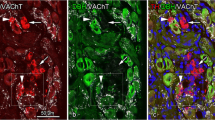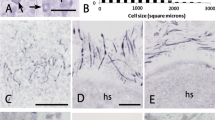Summary
The distribution and origin of nerve fibers of presumed sensory nature in the ear drum and middle-ear mucosa of the rat were studied by a retrograde tracing technique in combination with immunocytochemistry.
Application of True Blue (TB) on the ear drum or on the middle-ear mucosa labeled nerve cell bodies in the jugular, trigeminal, geniculate and cervical dorsal root ganglia (C2–C4). Judging from the number of TB-labeled nerve cell bodies the jugular and trigeminal ganglia contributed the major component to the sensory innervation of the ear drum and the middle-ear mucosa, while the contribution from the geniculate and cervical dorsal root ganglia was relatively minor.
The majority of the TB-labeled nerve cell bodies contained calcitonin gene-related peptide (CGRP), whereas minor populations stored substance P (SP) and neurokinin A (NKA). Nerve fibers containing SP, NKA and CGRP were moderate in number in the middle-ear mucosa and few in the ear drum. Double immunostaining revealed that SP invariably coexisted with NKA in nerve cell bodies in the ganglia examined. The SP/NKA-containing nerve cell bodies constituted a subpopulation of those storing CGRP.
The findings indicate that several ganglia project to the ear drum and middle-ear mucosa and that many neuropeptides are involved in the mediation of middle-ear sensitivity.
Similar content being viewed by others
References
Coons AH, Leduc EH, Connolly JM (1955) Studies on antibody production. I. A method for the histochemical demonstration of specific antibody and its application to a study of the hyper-immune rabbit. J Exp Med 102:49–60
Dalsgaard C-J, Hökfelt T, Elfvin L-G, Skirboll L, Emson P (1982) Substance P-containing primary sensory neurons projecting to the inferior mesenteric ganglion: Evidence from combined retrograde tracing and immunohistochemistry. Neuroscience 7:647–654
Furness JB, Costa M, Keast JR (1984) Choline acetyltransferase and peptide immunoreactivity of submucous neurons in the small intestine of the guinea-pig. Cell Tissue Res 237:329–336
Goycoolea M, Paparella M, Carpenter A-C (1982) Ganglia and ganglion cells in the middle ear. Arch Otolaryngol 108:276–277
Grunditz T, Håkanson R, Sundler F, Uddman R (1988) Neuronal pathways to the rat thyroid revealed by retrograde tracing and immunocytochemistry. Neuroscience (in press)
Ishii T, Kaga K (1976) Autonomic nervous system of the cat middle ear mucosa. Ann Otol 85 [suppl] 25:51–57
Jancso G, Kiraly E (1981) Sensory neurotoxins: Chemically induced selected destruction of primary sensory neurons. Brain Res 210:83–89
Jessell TM, Iversen LL, Cuello AC (1978) Capsaicin-induced depletion of substance P from primary sensory neurones. Brain Res 152:183–188
Lundberg J, Brodin E, Saria A (1984) Effects and distribution of vagal capsaicin-sensitive substance P neurons with special reference to the trachea and lungs. Acta Physiol Scand 119:243–252
Mitchell G.A.G (1954) The autonomic nerve supply of the throat, nose and ear. J Laryngol Otol 68:495–516
Rosen S (1950) The tympanic plexus. Arch Otolaryngol 52:15–18
Sawchenko PE, Swanson LM (1981) A method for tracing biochemically defined pathways in the central nervous system using combined fluorescence retrograde transport and immunohistochemical techniques. Brain Res 210:31–51
Skagerberg G, Björklund A, Lindvall O (1985) Further studies on the use of the fluorescent retrograde tracer True blue in combination with monoamine histochemistry. J Neurosci Methods 14:25–40
Sterner MR, Fox EA, Powley TL (1985) A retrograde tracer strategy using True blue to label the preganglionic parasympathetic innervation of the abdominal viscera. J Neurosci Methods 14:273–280
Tramu G, Pillez A, Leonardelli J (1978) An efficient method of antibody elution for the successive or simultaneous localization of two antigens by immunocytochemistry. J Histochem Cytochem 26:322–324
Uddman R, Kitajiri M, Sundler F (1983) Autonomic innervation of the middle ear. Ann Otol 92:151–154
Uddman R, Luts A, Sundler F (1985) Occurrence and distribution of calcitonin gene-related peptide in the mammalian respiratory tract and middle ear. Cell Tissue Res 241:551–555
Widemar L, Hellström S, Schultzberg M, Stenfors L-E (1985) Autonomic innervation of the tympanic membrane. An immunocytochemical and histofluorescence study. Acta Otolaryngol 100:58–65
Yeh Y, Kruger L (1984) Fine-structural characterization of the somatic innervation of the tympanic membrane in normal, sympathectomized, and neurotoxin-denervated rats. Somatoses Res 1:359–378
Author information
Authors and Affiliations
Rights and permissions
About this article
Cite this article
Uddman, R., Grunditz, T., Larsson, A. et al. Sensory innervation of the ear drum and middle-ear mucosa: Retrograde tracing and immunocytochemistry. Cell Tissue Res. 252, 141–146 (1988). https://doi.org/10.1007/BF00213835
Accepted:
Issue Date:
DOI: https://doi.org/10.1007/BF00213835




